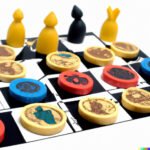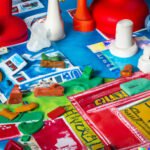Are you looking for classic board games for 3 year olds? Board games have been a beloved pastime for generations, and they offer a wide range of benefits for young children. In this article, we will explore the world of classic board games specifically designed for 3 year olds.
From the history of these timeless games to the educational value they provide, we’ll cover it all. Whether you’re a parent or caregiver, this guide will help you choose the right board game for your little one and make the most of your playtime together.
Playing classic board games at a young age has been shown to have numerous benefits for children. Not only are these games fun and entertaining, but they also promote cognitive development, social skills, motor skills, and emotional development. We’ll delve into these benefits in more detail and discuss how playing board games can support your child’s overall growth and development.
Choosing the right board game for a 3 year old can be overwhelming with so many options available. We’ll provide tips on how to select age-appropriate games that align with your child’s interests and abilities.
Additionally, we’ll offer guidance on how to introduce classic board games to your 3 year old and reinforce game rules in a way that is enjoyable and engaging. So, if you’re ready to embark on this delightful journey of classic board game play with your toddler, keep reading.
Top Classic Board Games for 3 Year Olds
When it comes to classic board games for 3 year olds, there are a variety of options that can provide educational and entertainment value. Here are some top picks for board games that are both age-appropriate and enjoyable for toddlers:
1. Candy Land: This colorful and imaginative game is perfect for young children, as it requires no reading skills and focuses on color recognition and matching. Playing Candy Land can help 3 year olds develop their cognitive skills and learn how to take turns.
2. Chutes and Ladders: Chutes and Ladders is a classic board game that teaches children about numbers, counting, and taking turns. It also helps kids understand the concept of cause and effect, as they move up ladders and slide down chutes based on their dice rolls.
3. Hi Ho. Cherry-O: This fun-filled game helps young children practice their counting skills while also reinforcing the importance of good sportsmanship, as players have to return cherries to the tree if they spill them from their baskets.
These classic board games provide numerous benefits for 3 year olds, including cognitive development, social interaction, and motor skill enhancement. When playing these games with your child, remember to offer praise for their efforts and focus on having fun together rather than winning or losing. With the right approach, classic board games can be an engaging and educational experience for both parents and toddlers alike.
Benefits of Playing Classic Board Games
Classic board games for 3 year olds offer a wide range of benefits that contribute to their overall development. From cognitive and motor skills to social and emotional growth, these games play an essential role in a child’s early years. One of the primary advantages of playing classic board games at this age is the enhancement of cognitive development. These games help improve memory, concentration, and problem-solving skills as children learn to strategize and make decisions.
Additionally, engaging in board game play at a young age can aid in the development of social skills. Through playing with others, 3 year olds have the opportunity to learn how to take turns, communicate effectively, and follow rules – all essential aspects of social interaction. Moreover, classic board games encourage the development of motor skills as children move game pieces or cards on the board while also fostering emotional growth by teaching patience and good sportsmanship.
| Benefit | Description |
|---|---|
| Cognitive Development | Improves memory, concentration, and problem-solving abilities |
| Social Skills | Teaches turn-taking, communication, and rule-following |
| Motor Skills | Allows for movement of game pieces/cards on the board |
| Emotional Development | Fosters patience and good sportsmanship |
How to Introduce Classic Board Games to a 3 Year Old
Introducing classic board games to a 3 year old can be an exciting and rewarding experience for both the child and the parent. However, it’s important to approach the introduction with care and consideration for the child’s age and developmental stage. When choosing a classic board game for a 3 year old, it’s crucial to select one that is not only age-appropriate but also engaging and educational.
When introducing classic board games to a 3 year old, it’s important to consider their attention span and ability to follow rules. Simple games with easy-to-understand instructions are ideal for this age group. Classics such as “Candy Land,” “Chutes and Ladders,” and “Memory” are great options that can help young children develop skills such as color recognition, counting, memory, and turn-taking.
It’s also essential to create a positive and inviting environment for playing board games with a 3 year old. Choose a time when your child is well-rested and in good spirits, and make sure the playing area is free from distractions.
Additionally, take into account your child’s mood – if they’re not feeling up for a game on a certain day, don’t force it. It’s important for board game play to be seen as fun rather than a chore or obligation.
| Classic Board Game | Age Appropriateness | Tips for Playing |
|---|---|---|
| Candy Land | 3+ | Use the colorful cards to guide your child through the game, reinforcing colors along the way. |
| Chutes and Ladders | 3+ | Encourage counting as you move through the board; praise your child when they reach ladders. |
| Memory |
Educational Value of Classic Board Games for 3 Year Olds
Classic board games for 3 year olds have a tremendous educational value that can help in the development of various skills in young children. Here are some of the ways in which classic board games can be beneficial for the educational development of 3 year olds:
- Language development: Board games often involve verbal communication, which helps children build their vocabulary and improve their language skills. Games like Memory Match or Alphabet Bingo can introduce new words to toddlers in a fun and engaging way.
- Math skills: Many classic board games involve counting, number recognition, and basic math operations. Games such as Candy Land or Chutes and Ladders can help young children develop their early math skills while also having fun.
- Problem-solving abilities: Playing board games requires children to think critically and strategize in order to achieve a goal. Games like Connect Four or Guess Who? can help 3 year olds practice problem-solving and logical thinking.
Incorporating these educational elements into board game play can help parents make learning fun for their 3 year olds while also spending quality time together.
Overall, classic board games for 3 year olds provide an excellent platform for educational growth while also promoting social interaction and good sportsmanship. By choosing age-appropriate games and actively participating in game play, parents can help their young children develop important skills that will benefit them throughout their lives.
Classic Board Games vs Digital Games for 3 Year Olds
When it comes to choosing the right kind of games for 3 year olds, many parents may find themselves debating between classic board games and digital games. Both options have their pros and cons, and it’s important to weigh them carefully before making a decision.
Classic Board Games
Classic board games have been a staple in childhood play for generations. They offer a tangible and hands-on experience that encourages social interaction and critical thinking skills. Board games also provide an opportunity for children to learn important lessons such as taking turns, following rules, and good sportsmanship. Additionally, playing board games with 3 year olds can help develop their fine motor skills as they manipulate game pieces and cards.
Digital Games
On the other hand, digital games can offer a different kind of learning experience for 3 year olds. They often feature bright colors, engaging animations, and interactive elements that can capture a child’s attention. Digital games can also be beneficial for introducing basic concepts such as shapes, colors, and numbers in a fun and engaging way. However, excessive screen time has been linked to various health issues in young children such as eye strain and interrupted sleep patterns.
Recommended Screen Time Guidelines
The American Academy of Pediatrics recommends that children between the ages of 2-5 years should engage in no more than one hour of high-quality screen media per day. This includes all forms of digital entertainment including TV shows, movies, video games, and educational apps. It’s important for parents to monitor and limit their child’s screen time to ensure that it does not interfere with other important activities such as physical playtime or reading.
Tips for Parental Involvement in Board Game Play
Parental involvement in board game play is crucial for a child’s overall development and enjoyment of the game. Here are some tips for parents on how to actively engage with their 3 year old during board game play:
Choose Age-Appropriate Games
When selecting classic board games for 3 year olds, it’s important to choose games that are suitable for their age and developmental stage. Look for games that have simple rules, short playing times, and colorful, engaging components. Games like Candy Land, Chutes and Ladders, or The Sneaky, Snacky Squirrel Game are great options for this age group.
Teach Good Sportsmanship
Board games provide an opportunity to teach children about winning and losing graciously. It’s important for parents to model good sportsmanship and encourage positive behavior during game play. Use moments of both victory and defeat as teaching opportunities to reinforce the importance of good sportsmanship.
Encourage Cooperation
Many classic board games for 3 year olds involve cooperative play, where players work together towards a shared goal. Games like Hoot Owl Hoot. or Richard Scarry’s Busytown: Eye Found It. promote teamwork and collaboration. Encourage your child to work together with others during game play and praise their efforts in cooperation.
By actively engaging with their child during board game play, parents can foster valuable skills such as good sportsmanship, cooperation, and critical thinking in their 3 year old while creating fun and lasting memories together.
Conclusion and Final Thoughts
In conclusion, classic board games for 3 year olds are not only a fun way to pass the time, but they also offer a wide range of developmental benefits. From cognitive and social skills development to language and math skills, these games can help toddlers learn important skills while having a great time. Moreover, classic board games offer a meaningful alternative to digital games and can help reduce screen time for young children.
It is important for parents to actively engage with their children during game play, teaching good sportsmanship and cooperation. Playing classic board games with 3 year olds not only fosters a love for learning and problem-solving, but it also strengthens the bond between parent and child. Additionally, parents should choose age-appropriate games that will challenge and entertain their children without causing frustration.
Frequently Asked Questions
What Board Games Are Good for 3 Year Olds?
Some board games that are good for 3-year-olds include “The Sneaky, Snacky Squirrel Game,” “Hi Ho! Cherry-O,” and “Count Your Chickens.” These games are simple, colorful, and help in developing basic skills.
What Game Can a 3 Year Old Play?
A 3-year-old can play simple matching games like Memory, or cooperative games like “First Orchard” or “Hoot Owl Hoot!” These games are designed with young children in mind and focus on developing skills like turn-taking and color recognition.
Can a 3 Year Old Play Candyland?
Yes, a 3-year-old can definitely play Candyland. This classic game is perfect for preschoolers as it’s easy to understand, has simple rules, and revolves around color matching – which is a skill most children develop at this age.

I love playing all kinds of games – from classics like Monopoly to modern favourites like Ticket to Ride.
I created this blog as a way to share my love of board games with others, and provide information on the latest releases and news in the industry.





